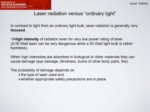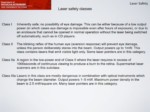بخشی از پاورپوینت
--- پاورپوینت شامل تصاویر میباشد ----
اسلاید 1 :
In contrast to light from an ordinary light bulb, laser radiation is generally very focused.
àHigh intensity of radiation even for very low power rating of laser.
(A 50 Watt laser can be very dangerous while a 50 Watt light bulb is rather harmless).
When high intensities are absorbed in biological or other materials they can cause damage (eye damage, blindness, burns of other body parts, fire).
The probability of damage depends on
the type of laser used and
whether appropriate safety precautions are in place.
اسلاید 2 :
Class I Inherently safe; no possibility of eye damage. This can be either because of a low output power (in which cases eye damage is impossible even after hours of exposure), or due to an enclosure that cannot be opened in normal operation without the laser being switched off automatically, such as in CD players.
Class II The blinking reflex of the human eye (aversion response) will prevent eye damage, unless the person deliberately stares into the beam. Output powers up to 1mW. This class contains lasers that emit visible light only. Some laser pointers are in this category.
Class IIa A region in the low-power end of Class II where the laser requires in excess of 1000seconds of continuous viewing to produce a burn to the retina. Supermarket laser scanners are in this subclass.
Class IIIa Lasers in this class are mostly dangerous in combination with optical instruments which change the beam diameter. Output powers 1–5 mW. Maximum power density in the beam is 2.5 mW/square cm. Many laser pointers are in this category.
اسلاید 3 :
Class IIIb Will cause damage if the beam enters the eye directly. This generally applies to lasers powered from 5–500 mW. Lasers in this category can easily cause permanent eye damage from exposures of 1/100th of a second or less depending on the strength of the laser. A diffuse reflection is generally not hazardous but specularreflections can be just as dangerous as direct exposures. Protective eyewear is always recommended when experimenting withIIIblasers. Lasers at the high power end of this class may also present a fire hazard and can lightly burn skin.
Class IV Highly dangerous. Lasers in this class have output powers of more than 500 mWin the beam, or produce intense pulses of light. These are cutting, etching and surgical lasers and can cause damage without being magnified by the optics of the eye. Diffusereflections of the laser beam can be hazardous to skin or eye within the Nominal Hazard Zone.
اسلاید 4 :
Generally one can state that a laser is more dangerous with:
(i) Higher power
Higher intensty means more power per time that can cause damage when the light is absorbed
(ii) Less visibility of its wavelength
Infrared and ultraviolet light will not cause the blinking reflex (aversion response)of the human eye, This means the retina will be exposed longer and the damagewill therefore be greater
(iii) Higher intensity (stronger focus of the light)
Stronger focus means more power per area which means that the damage may be more but at the same time worse.
اسلاید 5 :
Throughout the Modern Optics Lab, several laser types are used. All of them are visible and all will have power between 1mW and 4mW (class IIIa).
What you need to know (with regard to safety) about the lasers used in the Modern Optics Lab:
Protective eye wear is not required and burns of the skin are impossible as long as these lasers are not focused;
However: Be aware that when these lasers are handled inappropriately (by violation of the following safety rules), severe eye damage can occur nevertheless!
اسلاید 6 :
The lasers for the experiments will be installed in the experimental setup such that no direct exposure of the eye will be possible during operation of the lab. Do not change these setups especially do not move the lasers, do not take them out of their holders, do not take optical elements (mirrors, detectors, beam expanders etc.) out of setups UNLESS the lab procedure requires you to do so. If this is the case, turn off the laser before you do this or use a safe shutter to prevent any laser light emission or block the laser light with a paper shield.
When the LASERS are turned on, do not have your eyes on the level of the optical path of the laser beam. Your eyes may be exposed to the laser if an optical element is misaligned.
Do not put anything that has a reflecting surface (screw drivers, mirrors or other metallic objects) into the optical path of the laser beam. The beam may get reflected into your eyes.
Never reflect the laser beam out of an experiment, especially not toward your face or the face of other persons.
In the unlikely case of an accident resulting in an eye exposure with laser light which causes a visual effect that does not stop after the laboratory.




